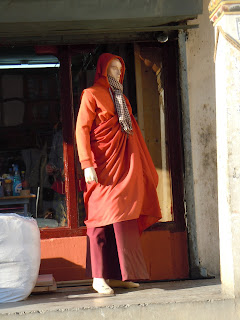To cross the river from the eastern side, one uses a traditional covered bridge festooned with prayer flags that leads directly into the city's food market where on weekends hundreds of peddlers sell everything from apples and mandarin oranges from Punakha to dried fish, spices, and vegetables from India and China.
Though the most urban of all Bhutan's "cities," replete with coffee shops, bars, Thai and Indian restaurants and countless excellent bookshops, Thimphu still reflects traditional Bhutanese culture. Clocktower Square, at the center of the city, has rows of prayer wheels on each side and members of the community gather in the Square every morning to spin them and to pray.
There are some sites one can see only in Asia, and perhaps only in a very Buddhist country, such as this mannikin outside a shop that sells clothes and accoutrements for monks and nuns:
Best of all, since the winter air is so clear and the sun always shines in January, in Thimphu one can simultaneously see BOTH the Standing Buddha in Coronation Park AND the largest seated Buddha in the world (look carefully--they alost line up!):








The picture of Buddha in Coronation Park looks as if he is keeping watch over the city. If you spend some time looking at the picture, it seems as if the color choices of the buildings were chosen to complement him. I see no Miami Art Deco paint or architecture anywhere in this picture!
ReplyDeleteSince I had no point of reference of what a prayer wheel could be, I had to look it up. For those of you who may be as clueless as me,
http://en.wikipedia.org/wiki/Prayer_wheel
I spent quite a bit of time researching prayer wheels. Many of them are a work of art and are very beautiful. I wonder if some of them are handed down as perhaps a family heirloom.